Mandala art combines beautiful patterns with deep spiritual roots from Hindu and Buddhist traditions. The symmetrical designs feature repetitive motifs that radiate from a center point, creating a mesmerizing visual journey. Artists use circles, geometric shapes, and flowing lines to craft these intricate compositions. The rhythmic process of creating or coloring mandalas calms the mind, reduces stress, and promotes mindfulness. These aesthetic patterns offer more than just beauty—they invite a peaceful escape from daily chaos.
Key Takeaways
- Repetitive circular patterns in mandalas create a meditative rhythm that naturally calms the nervous system during both creation and viewing.
- Symmetrical designs with balanced motifs provide visual harmony that soothes the mind and promotes psychological equilibrium.
- Flowing, continuous lines in mandala art represent cosmic connectedness and guide viewers into a relaxed, contemplative state.
- Working from the center outward with consistent spacing between elements establishes order that reduces mental chaos and anxiety.
- Strategic use of cool-toned color palettes featuring blues and greens enhances the calming properties of mandala artwork.
The Origins and Spiritual Significance of Mandala Art
Circles have long held deep meaning across human cultures, and nowhere is this more evident than in mandala art. These intricate circular designs originated from the Sanskrit word for “circle,” representing the wholeness of life and the universe itself.
Mandalas aren’t just pretty patterns—they carry deep spiritual significance in Hindu and Buddhist traditions, where they symbolize cosmic connections and divine energies.
Buddhist monks create amazing sand mandalas, only to sweep them away afterward (can you believe it?), showing that nothing lasts forever. Meanwhile, Hindus use mandalas called yantras during meditation to invite spiritual awakening.
Today, creating these circular masterpieces has become a popular form of art therapy, helping people focus their minds, reduce stress, and discover inner peace through the calming repetitive process of drawing concentric patterns.
Essential Supplies for Creating Your First Mandala Design
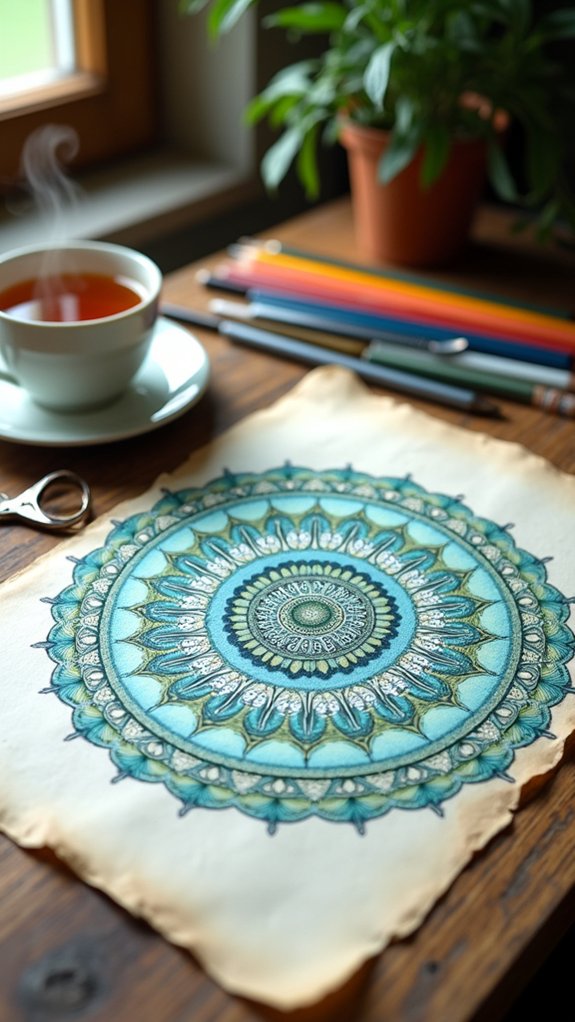
Creating your first mandala requires a thoughtful selection of supplies that will make the process both enjoyable and successful.
Basic drawing tools like pencils, erasers, a compass, and a ruler form the foundation of your mandala toolkit, while choosing smooth paper with enough weight to handle multiple erasures can prevent frustration.
Once you’ve completed your design, the real magic happens when you bring it to life with colored pencils, markers, or even watercolors – transforming simple patterns into a vibrant work of art!
Basic Drawing Tools
When starting on your mandala art journey, having the right tools can make all the difference between frustration and creative flow. Every stunning mandala begins with some surprisingly simple supplies!
For drawing a mandala, smooth paper provides the perfect canvas for your creation, while a compass helps form those perfectly round circles that serve as the foundation for basic shapes.
Don’t forget a trusty ruler—it’s essential for creating symmetrical lines that will transform into intricate designs. Pencils are your best friends for initial sketches, and paired with a quality eraser, they allow for mistake-free experimentation.
Want to take your art up a notch? A protractor divides your circle into equal parts, while fine-tip pens add gorgeous details.
Beginners might love using stencils—they’re total lifesavers when you’re just getting started!
Paper Selection Matters
Though artists often focus on fancy tools and techniques, the foundation of every beautiful mandala actually begins with the paper you select. The right paper can make or break your artwork, especially when creating intricate details that mandalas are famous for!
| Paper Type | Weight (gsm) | Best For |
|---|---|---|
| Sketch Paper | 80-100 | Beginners |
| Cardstock | 200+ | Markers/Pens |
| Watercolor | 300+ | Paints |
| Bristol | 250-300 | Professional work |
Look for acid-free options to keep your masterpiece from turning yellow over time. Smooth paper prevents annoying smudges, while textured papers can create cool effects with watercolors. Heavier papers won’t warp when you’re coloring intensely or using wet media. Trust me, your future mandala-drawing self will thank you for making smart paper selection choices now!
Coloring Supply Options
The journey into mandala artistry truly begins with selecting the right coloring tools for your creative vision. Quality coloring supplies transform simple patterns into vibrant works of art!
Colored pencils offer smooth blending capabilities, perfect for creating subtle gradients and layering colors to add impressive depth to intricate designs. Markers deliver bold, eye-catching results when you want your mandala to pop with intense color and clean lines.
- Watercolors provide a dreamy, fluid effect that can make your mandala seem to glow from within.
- Colored pencils work great for beginners since mistakes are easier to fix and control is simpler.
- Markers come in various tip sizes, letting you switch between detailed work and filling larger spaces.
Having a rainbow of color options guarantees your mandala will reflect your unique creative energy!
Step-by-Step Technique for Drawing Perfect Symmetrical Patterns
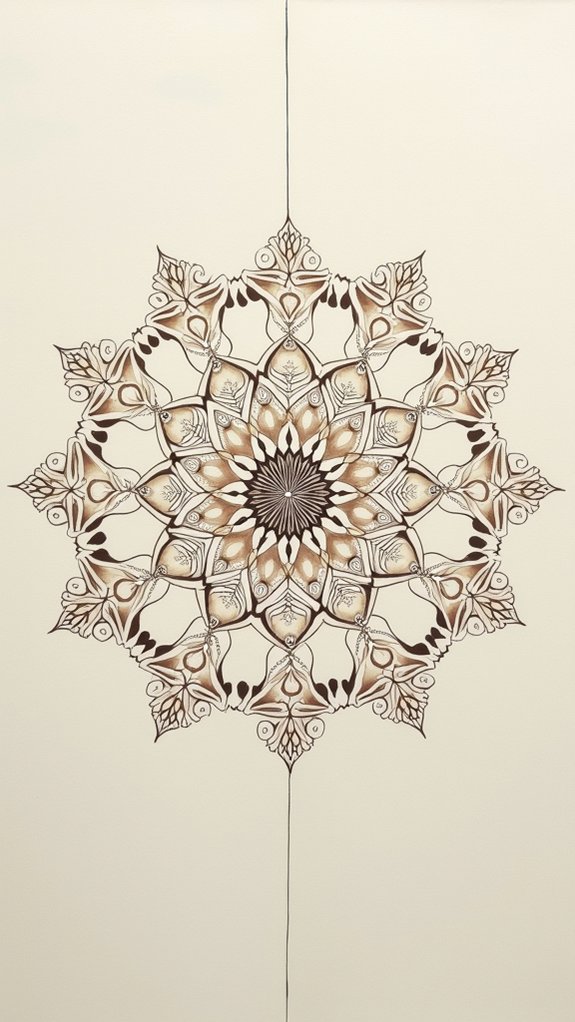
Creating perfect symmetrical patterns lies at the heart of stunning mandala art, and anyone can master this technique with practice and patience. The journey begins with a single dot at the center of your paper, which serves as the anchor for all geometric shapes that follow.
Artists typically use a compass to draw evenly spaced circles around this central point, creating the mandala’s framework.
Next, grab a protractor to divide these circles into equal sections—like slicing a pie! This essential step guarantees your drawing maintains balance throughout.
Work from the center outward, adding repeating patterns in each segment. Isn’t it amazing how simple shapes transform into complex designs?
Remember to pause occasionally and check your work for symmetry. Little adjustments along the way prevent major headaches later when your mandala grows more detailed and intricate!
Color Theory and Palette Selection for Harmonious Mandala Art

Color choices can make or break a mandala’s impact, with complementary colors adding serious wow-factor and depth to your circular designs.
Artists often use monochromatic schemes—various shades of just one color—to create a focused, meditative feel that draws viewers into the mandala’s center.
The colors you pick aren’t just pretty; they actually affect how people feel when they look at your art, with warm tones energizing viewers and cool blues and purples bringing a sense of calm.
Complementary Colors Enhance Depth
Many artists discover that complementary colors create magic in mandala art, transforming flat designs into vibrant, eye-catching masterpieces. When pairs like blue and orange or purple and yellow face off across the color wheel, they generate a dynamic visual depth that makes patterns pop!
Artists strategically place these color combos to guide the viewer’s eye through the intricate details of their mandalas.
- Using one dominant color with its complementary partner creates balance without overwhelming the design
- Varying shades and tints adds dimension, making geometric patterns appear to flow and pulse
- Strategic placement of complementary colors creates focal points that draw attention to meaningful symbols
The beauty of this approach lies in how it evokes emotions while enhancing the meditative quality of mandala art, making each piece not just something to see but something to experience.
Monochromatic Schemes Create Focus
Simplicity holds remarkable power in the world of mandala art, especially when artists embrace the subtle magic of monochromatic color schemes. By focusing on various shades of a single color, artists create a soothing visual experience that amplifies the meditative quality of their work. The brain isn’t busy jumping between different hues, allowing viewers to sink deeper into the intricate patterns.
Artists cleverly use different intensities of the same color to create surprising depth—light teal fading into deep turquoise can make flat designs pop with dimension! This approach prevents the visual overwhelm that sometimes happens with rainbow-colored mandalas.
Plus, working within these color limits becomes a mindfulness exercise itself, as creators must pay extra attention to how shadows and highlights interact. Who knew that sticking to one color could reveal so many possibilities?
Color Psychology Affects Mood
Moving beyond single-color creations, the fascinating world of color psychology opens up entirely new dimensions in mandala art. The colors chosen can dramatically shift the viewer’s emotional response, with warm tones sparking joy and cool hues promoting calmness.
Artists often select colors based on their intended mental health benefits, creating mandalas that serve specific emotional needs.
- Red and orange mandalas boost energy and passion, perfect for morning meditation.
- Blue and green compositions promote relaxation and stress reduction.
- Purple and indigo designs enhance spiritual connection and intuitive thought.
When creating mandalas, the strategic use of vibrant colors versus subdued tones matters tremendously. A balanced palette creates harmony, while intentional contrasts can energize specific sections.
Personal color associations also play a huge role—the colors that comfort you will likely differ from someone else’s calming palette!
Mindfulness Benefits of Practicing Repetitive Mandala Artistry
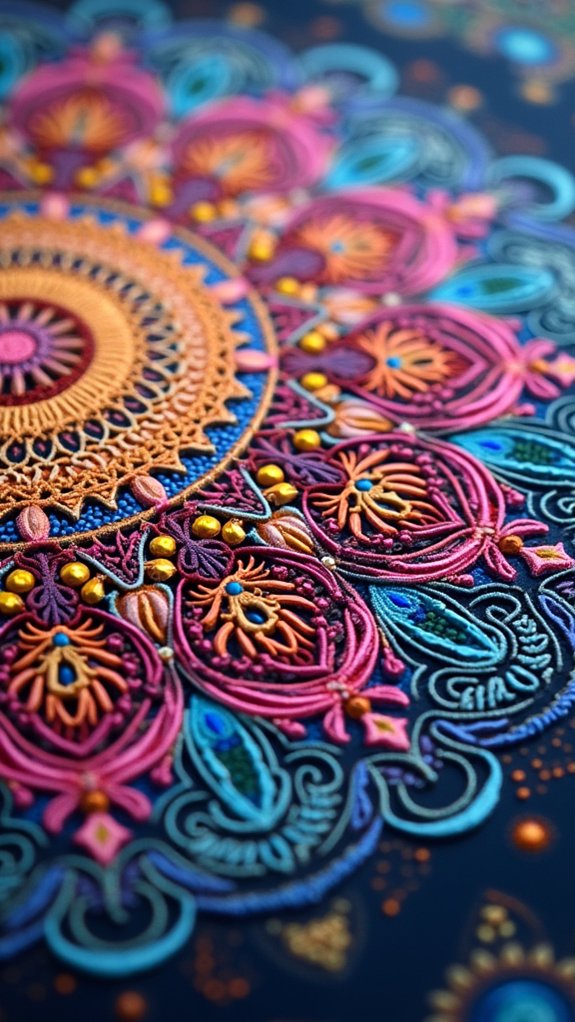
Mindfulness, a state of active attention to the present moment, blossoms naturally when creating mandala art. The rhythmic, repetitive process of drawing circular patterns pulls the mind away from worries, anchoring artists in the now.
In the swirl of each circular pattern, our racing thoughts quiet, replaced by the gentle rhythm of present-moment awareness.
Studies show that this focused attention actually triggers dopamine release in the brain, boosting mood while reducing anxiety!
As a form of art therapy, mandalas offer a creative escape that helps alleviate stress without requiring artistic expertise. The simple act of following patterns improves concentration—super helpful for students who struggle to focus.
Imagine sitting down feeling frazzled, then standing up refreshed just thirty minutes later! The best part? This mindfulness practice can become a daily habit, giving your brain a much-needed break from the chaos of everyday life.
Exploring Various Mandala Styles Across Different Cultures
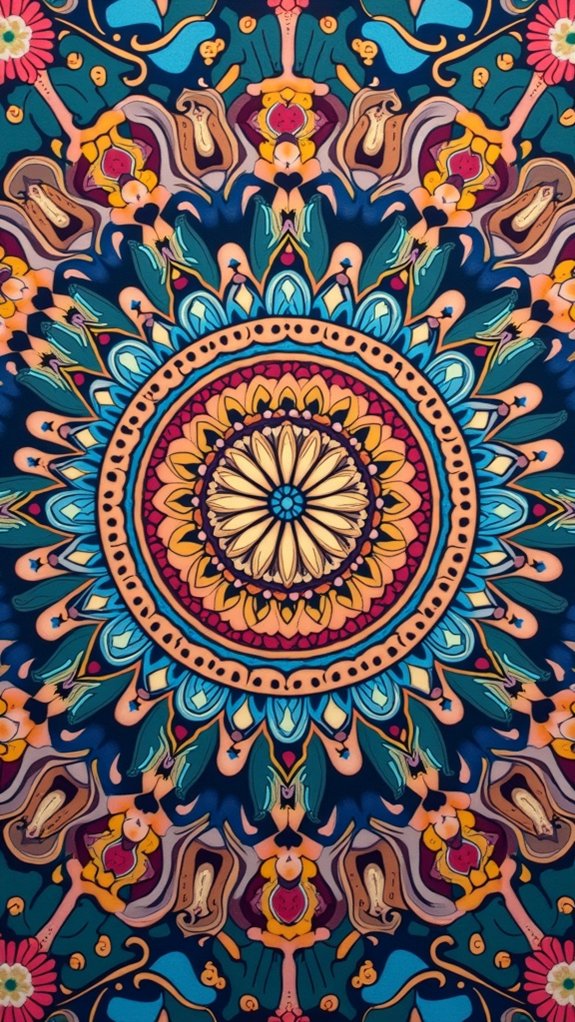
While mindfulness emerges through creating mandala art, the incredible diversity of styles across cultures reveals humanity’s shared attraction to circular symbolism. This fascinating art form varies dramatically across different cultures, each infusing their unique spiritual meanings and aesthetic preferences.
Hindu mandalas feature square designs with deities centered, while Buddhist monks create temporary sand mandalas—talk about patience!
- Native American medicine wheels connect the four directions, using natural materials to represent life’s interconnectedness.
- Islamic mandalas showcase mind-blowing geometric patterns that symbolize Allah’s infinite nature.
- Celtic mandala design incorporates intricate knots and spirals that tell stories about life cycles.
These cultural variations show how mandala design speaks a universal language while honoring distinct traditions.
Whether in African tribal celebrations or mosque decorations, these circular wonders continue to unite and inspire people worldwide.
Digital Tools and Applications for Modern Mandala Creation

In an age where technology meets tradition, digital tools have revolutionized how artists create mandala art. Software like Adobe Illustrator and Procreate offers amazing features—symmetry tools, layers, and customizable brushes—that make mandala creation both precise and flexible.
Artists can now instantly experiment with colors and patterns without starting over from scratch! The portability of drawing apps has been a game-changer too. Imagine crafting intricate mandalas while sitting in a park or during a lunch break using just a tablet or smartphone!
The freedom to create anywhere has transformed mandala art from studio practice to spontaneous everyday magic.
Plus, these digital platforms connect creators through online challenges and tutorials. Beginners can use pre-made templates and stencils to get started, while experienced artists push boundaries with advanced techniques.
The digital revolution hasn’t replaced traditional methods—it’s expanded the mandala universe in exciting new ways!
Frequently Asked Questions
How Long Does It Typically Take to Complete a Detailed Mandala?
Creating detailed mandalas requires effective time management, with completion times varying from hours to weeks depending on artistic techniques employed and the complexity of intricate designs chosen by the artist.
Can Left-Handed Artists Create Mandalas With the Same Techniques?
Left-handed artists achieve identical mandala symmetry through creative adaptations. They utilize the same techniques with natural adjustments to hand positioning and tool orientation, preserving artistic integrity across handedness preferences.
Are There Copyright Concerns When Selling Mandala Art Commercially?
Commercial mandala art sales require attention to copyright laws. Artists should create original mandala designs rather than copying traditional patterns. Proper commercial art licensing safeguards creators when selling their unique works.
What Materials Work Best for Outdoor or Weather-Resistant Mandala Displays?
Outdoor mandala displays benefit from ceramic tiles, metal, treated wood, and UV-resistant paints. Weather-resistant finishes like polyurethane and epoxy extend longevity. Periodic maintenance includes cleaning and resealing exposed surfaces annually.
Can Mandala Practice Help With Specific Mental Health Conditions?
Research suggests mandala meditation benefits various mental health therapy approaches. The focused, creative expression involved can alleviate anxiety, depression, and PTSD symptoms while promoting mindfulness and emotional regulation.
Conclusion
Mandala art offers an amazing journey into creativity and inner peace that anyone can enjoy. From ancient traditions to digital designs, these beautiful patterns help calm busy minds while expressing unique artistic vision. Whether you’re drawing your first symmetrical design or exploring cultural styles, mandalas connect us to something bigger than ourselves. So grab your supplies, find your center, and let the repetitive, flowing patterns of mandala art bring balance to your life!

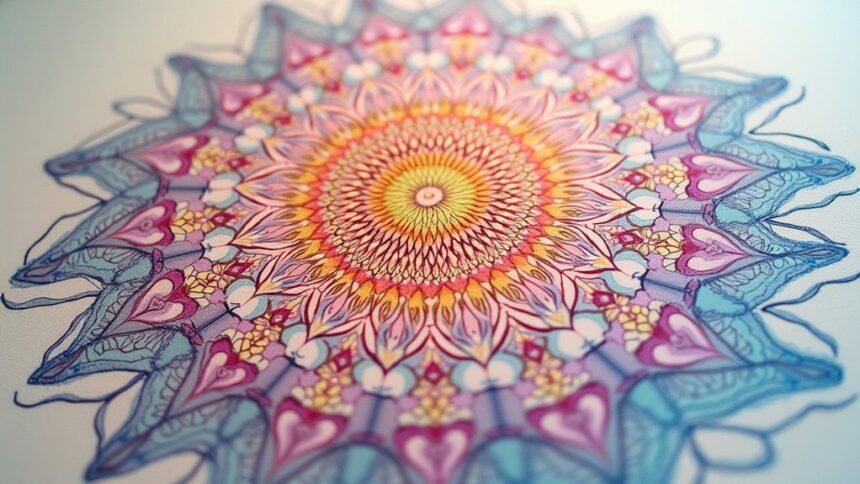
Leave a Reply